Convergence and Divergence in HRM: US and Germany Employment Systems
VerifiedAdded on 2022/08/14
|7
|1371
|12
Essay
AI Summary
This essay provides a comparative analysis of the human resource management (HRM) practices in the United States and Germany. The paper examines the convergence and divergence of the two countries' national employment systems, considering factors such as skills and vocational training, international labor standards, and industrial relations (trade unions). The analysis considers the influence of multinational corporations (MNCs) and global integration. The essay highlights key differences, such as Germany's robust vocational training system and stronger trade unions compared to the USA. It also acknowledges points of convergence, such as US government investments in vocational training, while also discussing the divergence in international labor standards. The essay concludes that cultural diversity plays a significant role in these differences, leading to varied approaches to international HRM practices and emphasizing the importance of understanding these differences for effective implementation.
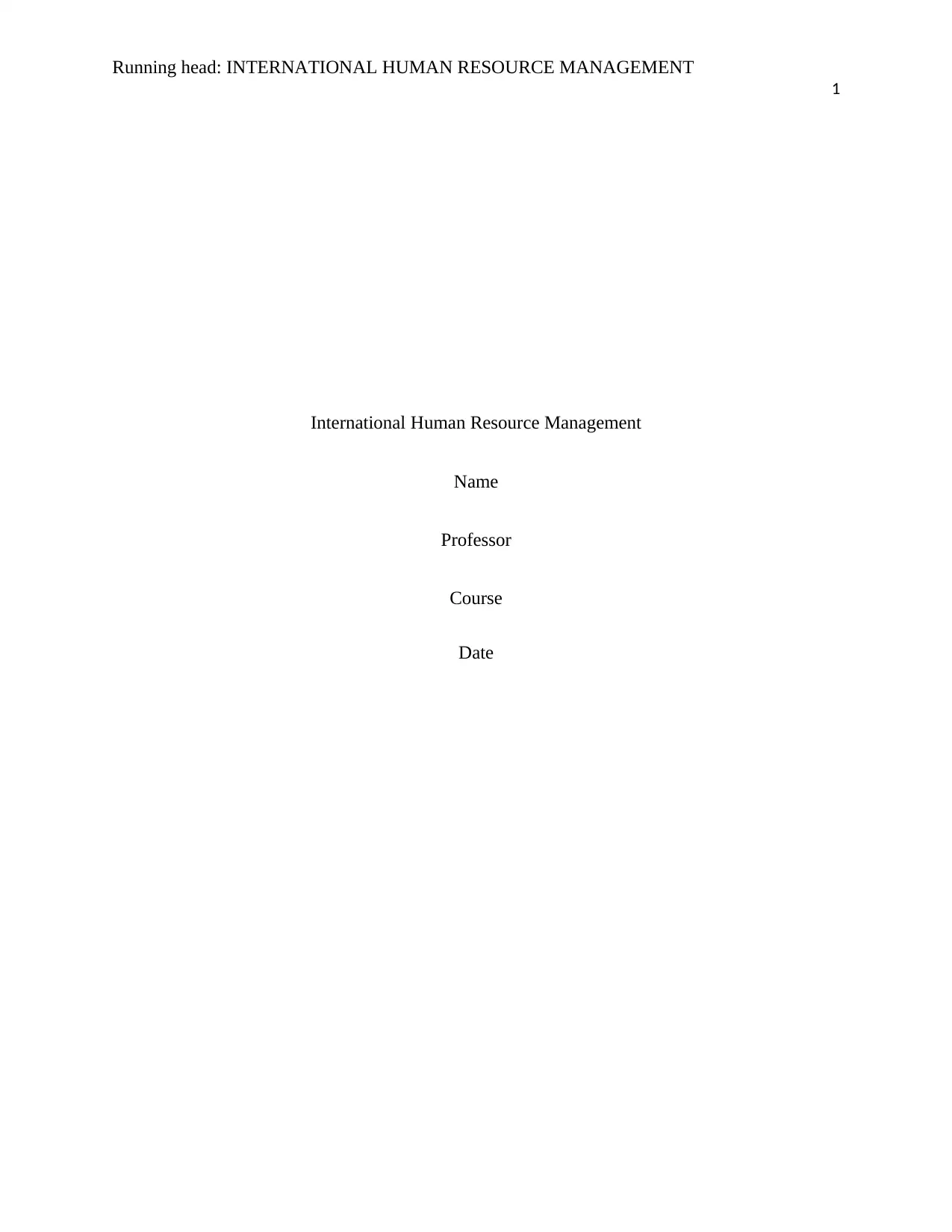
Running head: INTERNATIONAL HUMAN RESOURCE MANAGEMENT
1
International Human Resource Management
Name
Professor
Course
Date
1
International Human Resource Management
Name
Professor
Course
Date
Paraphrase This Document
Need a fresh take? Get an instant paraphrase of this document with our AI Paraphraser
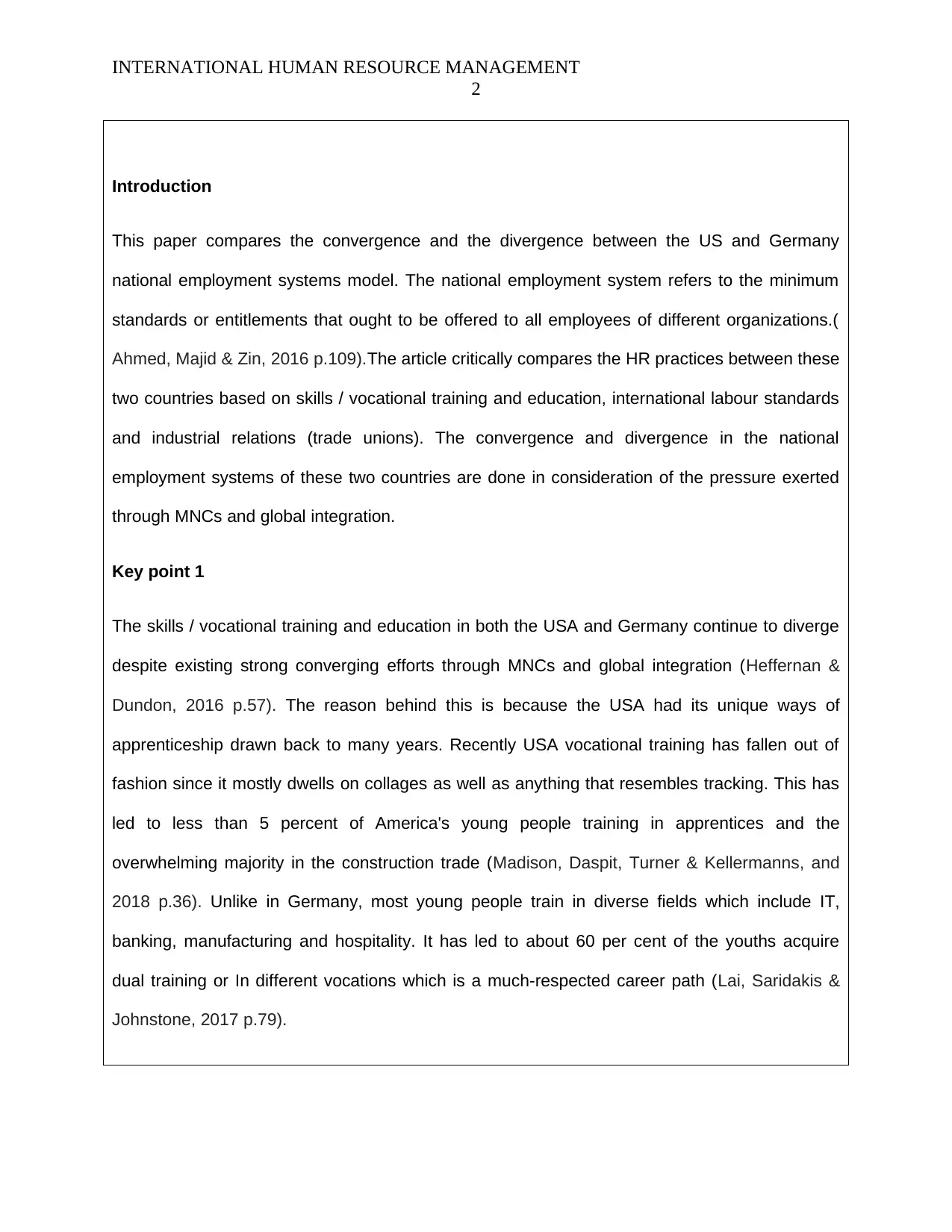
INTERNATIONAL HUMAN RESOURCE MANAGEMENT
2
Introduction
This paper compares the convergence and the divergence between the US and Germany
national employment systems model. The national employment system refers to the minimum
standards or entitlements that ought to be offered to all employees of different organizations.(
Ahmed, Majid & Zin, 2016 p.109).The article critically compares the HR practices between these
two countries based on skills / vocational training and education, international labour standards
and industrial relations (trade unions). The convergence and divergence in the national
employment systems of these two countries are done in consideration of the pressure exerted
through MNCs and global integration.
Key point 1
The skills / vocational training and education in both the USA and Germany continue to diverge
despite existing strong converging efforts through MNCs and global integration (Heffernan &
Dundon, 2016 p.57). The reason behind this is because the USA had its unique ways of
apprenticeship drawn back to many years. Recently USA vocational training has fallen out of
fashion since it mostly dwells on collages as well as anything that resembles tracking. This has
led to less than 5 percent of America's young people training in apprentices and the
overwhelming majority in the construction trade (Madison, Daspit, Turner & Kellermanns, and
2018 p.36). Unlike in Germany, most young people train in diverse fields which include IT,
banking, manufacturing and hospitality. It has led to about 60 per cent of the youths acquire
dual training or In different vocations which is a much-respected career path (Lai, Saridakis &
Johnstone, 2017 p.79).
2
Introduction
This paper compares the convergence and the divergence between the US and Germany
national employment systems model. The national employment system refers to the minimum
standards or entitlements that ought to be offered to all employees of different organizations.(
Ahmed, Majid & Zin, 2016 p.109).The article critically compares the HR practices between these
two countries based on skills / vocational training and education, international labour standards
and industrial relations (trade unions). The convergence and divergence in the national
employment systems of these two countries are done in consideration of the pressure exerted
through MNCs and global integration.
Key point 1
The skills / vocational training and education in both the USA and Germany continue to diverge
despite existing strong converging efforts through MNCs and global integration (Heffernan &
Dundon, 2016 p.57). The reason behind this is because the USA had its unique ways of
apprenticeship drawn back to many years. Recently USA vocational training has fallen out of
fashion since it mostly dwells on collages as well as anything that resembles tracking. This has
led to less than 5 percent of America's young people training in apprentices and the
overwhelming majority in the construction trade (Madison, Daspit, Turner & Kellermanns, and
2018 p.36). Unlike in Germany, most young people train in diverse fields which include IT,
banking, manufacturing and hospitality. It has led to about 60 per cent of the youths acquire
dual training or In different vocations which is a much-respected career path (Lai, Saridakis &
Johnstone, 2017 p.79).
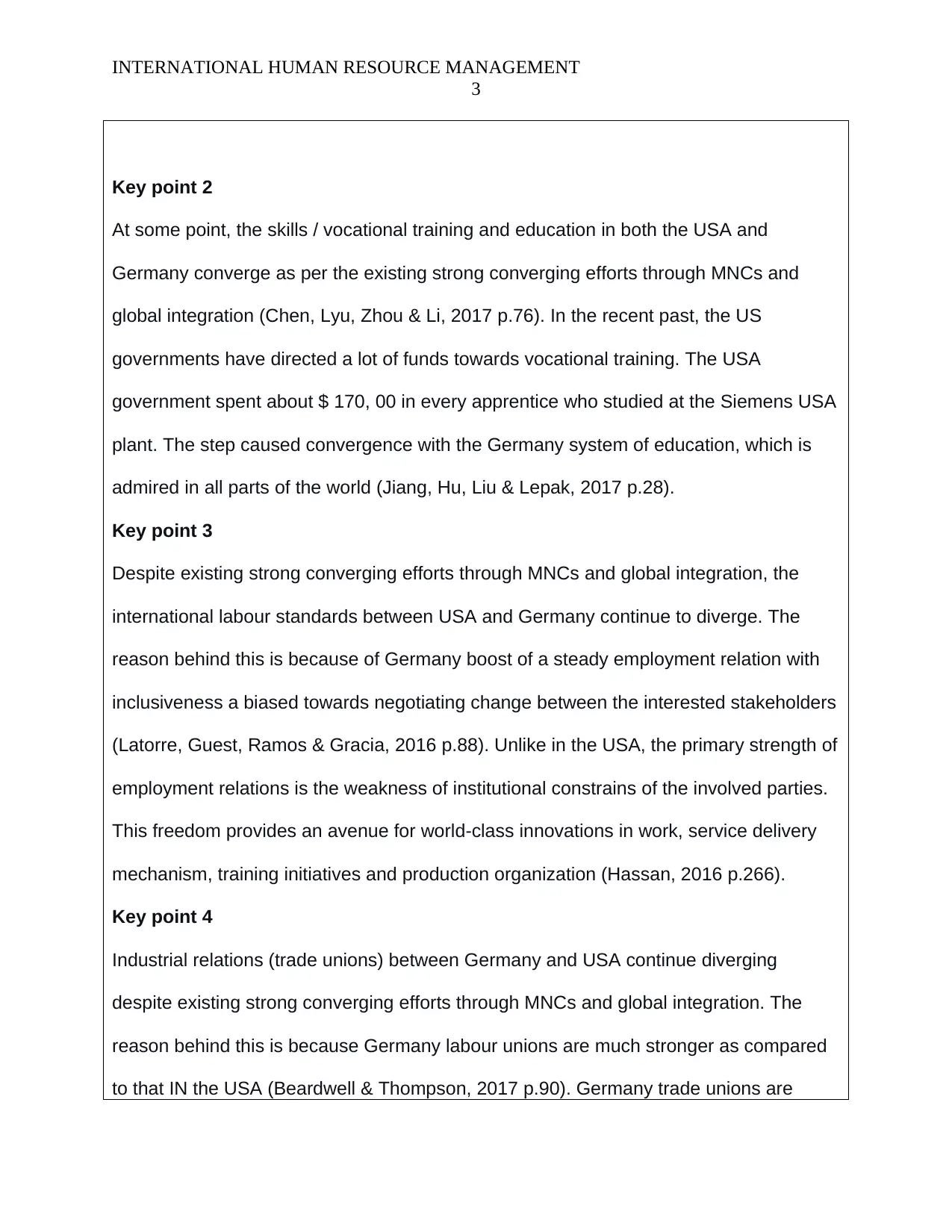
INTERNATIONAL HUMAN RESOURCE MANAGEMENT
3
Key point 2
At some point, the skills / vocational training and education in both the USA and
Germany converge as per the existing strong converging efforts through MNCs and
global integration (Chen, Lyu, Zhou & Li, 2017 p.76). In the recent past, the US
governments have directed a lot of funds towards vocational training. The USA
government spent about $ 170, 00 in every apprentice who studied at the Siemens USA
plant. The step caused convergence with the Germany system of education, which is
admired in all parts of the world (Jiang, Hu, Liu & Lepak, 2017 p.28).
Key point 3
Despite existing strong converging efforts through MNCs and global integration, the
international labour standards between USA and Germany continue to diverge. The
reason behind this is because of Germany boost of a steady employment relation with
inclusiveness a biased towards negotiating change between the interested stakeholders
(Latorre, Guest, Ramos & Gracia, 2016 p.88). Unlike in the USA, the primary strength of
employment relations is the weakness of institutional constrains of the involved parties.
This freedom provides an avenue for world-class innovations in work, service delivery
mechanism, training initiatives and production organization (Hassan, 2016 p.266).
Key point 4
Industrial relations (trade unions) between Germany and USA continue diverging
despite existing strong converging efforts through MNCs and global integration. The
reason behind this is because Germany labour unions are much stronger as compared
to that IN the USA (Beardwell & Thompson, 2017 p.90). Germany trade unions are
3
Key point 2
At some point, the skills / vocational training and education in both the USA and
Germany converge as per the existing strong converging efforts through MNCs and
global integration (Chen, Lyu, Zhou & Li, 2017 p.76). In the recent past, the US
governments have directed a lot of funds towards vocational training. The USA
government spent about $ 170, 00 in every apprentice who studied at the Siemens USA
plant. The step caused convergence with the Germany system of education, which is
admired in all parts of the world (Jiang, Hu, Liu & Lepak, 2017 p.28).
Key point 3
Despite existing strong converging efforts through MNCs and global integration, the
international labour standards between USA and Germany continue to diverge. The
reason behind this is because of Germany boost of a steady employment relation with
inclusiveness a biased towards negotiating change between the interested stakeholders
(Latorre, Guest, Ramos & Gracia, 2016 p.88). Unlike in the USA, the primary strength of
employment relations is the weakness of institutional constrains of the involved parties.
This freedom provides an avenue for world-class innovations in work, service delivery
mechanism, training initiatives and production organization (Hassan, 2016 p.266).
Key point 4
Industrial relations (trade unions) between Germany and USA continue diverging
despite existing strong converging efforts through MNCs and global integration. The
reason behind this is because Germany labour unions are much stronger as compared
to that IN the USA (Beardwell & Thompson, 2017 p.90). Germany trade unions are
⊘ This is a preview!⊘
Do you want full access?
Subscribe today to unlock all pages.

Trusted by 1+ million students worldwide
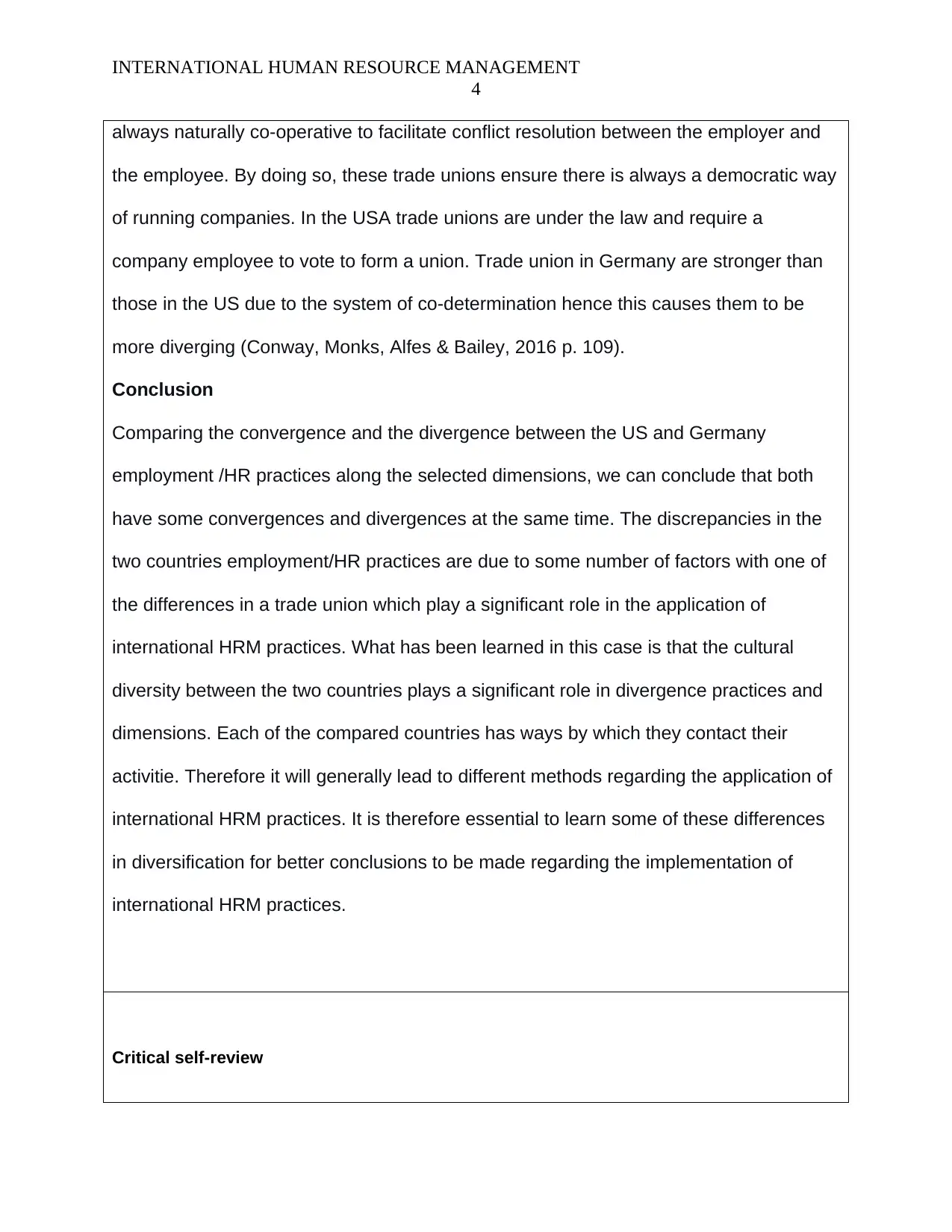
INTERNATIONAL HUMAN RESOURCE MANAGEMENT
4
always naturally co-operative to facilitate conflict resolution between the employer and
the employee. By doing so, these trade unions ensure there is always a democratic way
of running companies. In the USA trade unions are under the law and require a
company employee to vote to form a union. Trade union in Germany are stronger than
those in the US due to the system of co-determination hence this causes them to be
more diverging (Conway, Monks, Alfes & Bailey, 2016 p. 109).
Conclusion
Comparing the convergence and the divergence between the US and Germany
employment /HR practices along the selected dimensions, we can conclude that both
have some convergences and divergences at the same time. The discrepancies in the
two countries employment/HR practices are due to some number of factors with one of
the differences in a trade union which play a significant role in the application of
international HRM practices. What has been learned in this case is that the cultural
diversity between the two countries plays a significant role in divergence practices and
dimensions. Each of the compared countries has ways by which they contact their
activitie. Therefore it will generally lead to different methods regarding the application of
international HRM practices. It is therefore essential to learn some of these differences
in diversification for better conclusions to be made regarding the implementation of
international HRM practices.
Critical self-review
4
always naturally co-operative to facilitate conflict resolution between the employer and
the employee. By doing so, these trade unions ensure there is always a democratic way
of running companies. In the USA trade unions are under the law and require a
company employee to vote to form a union. Trade union in Germany are stronger than
those in the US due to the system of co-determination hence this causes them to be
more diverging (Conway, Monks, Alfes & Bailey, 2016 p. 109).
Conclusion
Comparing the convergence and the divergence between the US and Germany
employment /HR practices along the selected dimensions, we can conclude that both
have some convergences and divergences at the same time. The discrepancies in the
two countries employment/HR practices are due to some number of factors with one of
the differences in a trade union which play a significant role in the application of
international HRM practices. What has been learned in this case is that the cultural
diversity between the two countries plays a significant role in divergence practices and
dimensions. Each of the compared countries has ways by which they contact their
activitie. Therefore it will generally lead to different methods regarding the application of
international HRM practices. It is therefore essential to learn some of these differences
in diversification for better conclusions to be made regarding the implementation of
international HRM practices.
Critical self-review
Paraphrase This Document
Need a fresh take? Get an instant paraphrase of this document with our AI Paraphraser
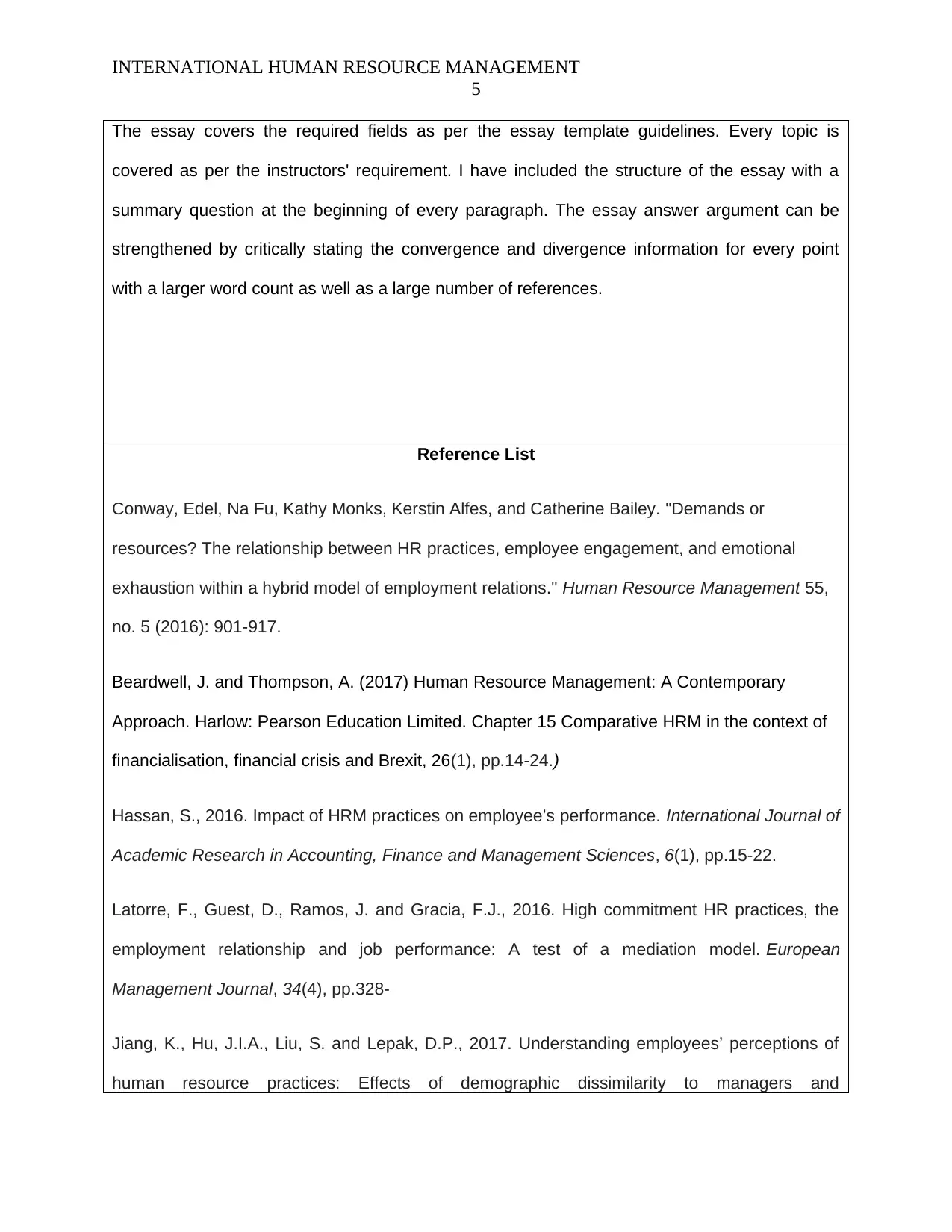
INTERNATIONAL HUMAN RESOURCE MANAGEMENT
5
The essay covers the required fields as per the essay template guidelines. Every topic is
covered as per the instructors' requirement. I have included the structure of the essay with a
summary question at the beginning of every paragraph. The essay answer argument can be
strengthened by critically stating the convergence and divergence information for every point
with a larger word count as well as a large number of references.
Reference List
Conway, Edel, Na Fu, Kathy Monks, Kerstin Alfes, and Catherine Bailey. "Demands or
resources? The relationship between HR practices, employee engagement, and emotional
exhaustion within a hybrid model of employment relations." Human Resource Management 55,
no. 5 (2016): 901-917.
Beardwell, J. and Thompson, A. (2017) Human Resource Management: A Contemporary
Approach. Harlow: Pearson Education Limited. Chapter 15 Comparative HRM in the context of
financialisation, financial crisis and Brexit, 26(1), pp.14-24.)
Hassan, S., 2016. Impact of HRM practices on employee’s performance. International Journal of
Academic Research in Accounting, Finance and Management Sciences, 6(1), pp.15-22.
Latorre, F., Guest, D., Ramos, J. and Gracia, F.J., 2016. High commitment HR practices, the
employment relationship and job performance: A test of a mediation model. European
Management Journal, 34(4), pp.328-
Jiang, K., Hu, J.I.A., Liu, S. and Lepak, D.P., 2017. Understanding employees’ perceptions of
human resource practices: Effects of demographic dissimilarity to managers and
5
The essay covers the required fields as per the essay template guidelines. Every topic is
covered as per the instructors' requirement. I have included the structure of the essay with a
summary question at the beginning of every paragraph. The essay answer argument can be
strengthened by critically stating the convergence and divergence information for every point
with a larger word count as well as a large number of references.
Reference List
Conway, Edel, Na Fu, Kathy Monks, Kerstin Alfes, and Catherine Bailey. "Demands or
resources? The relationship between HR practices, employee engagement, and emotional
exhaustion within a hybrid model of employment relations." Human Resource Management 55,
no. 5 (2016): 901-917.
Beardwell, J. and Thompson, A. (2017) Human Resource Management: A Contemporary
Approach. Harlow: Pearson Education Limited. Chapter 15 Comparative HRM in the context of
financialisation, financial crisis and Brexit, 26(1), pp.14-24.)
Hassan, S., 2016. Impact of HRM practices on employee’s performance. International Journal of
Academic Research in Accounting, Finance and Management Sciences, 6(1), pp.15-22.
Latorre, F., Guest, D., Ramos, J. and Gracia, F.J., 2016. High commitment HR practices, the
employment relationship and job performance: A test of a mediation model. European
Management Journal, 34(4), pp.328-
Jiang, K., Hu, J.I.A., Liu, S. and Lepak, D.P., 2017. Understanding employees’ perceptions of
human resource practices: Effects of demographic dissimilarity to managers and
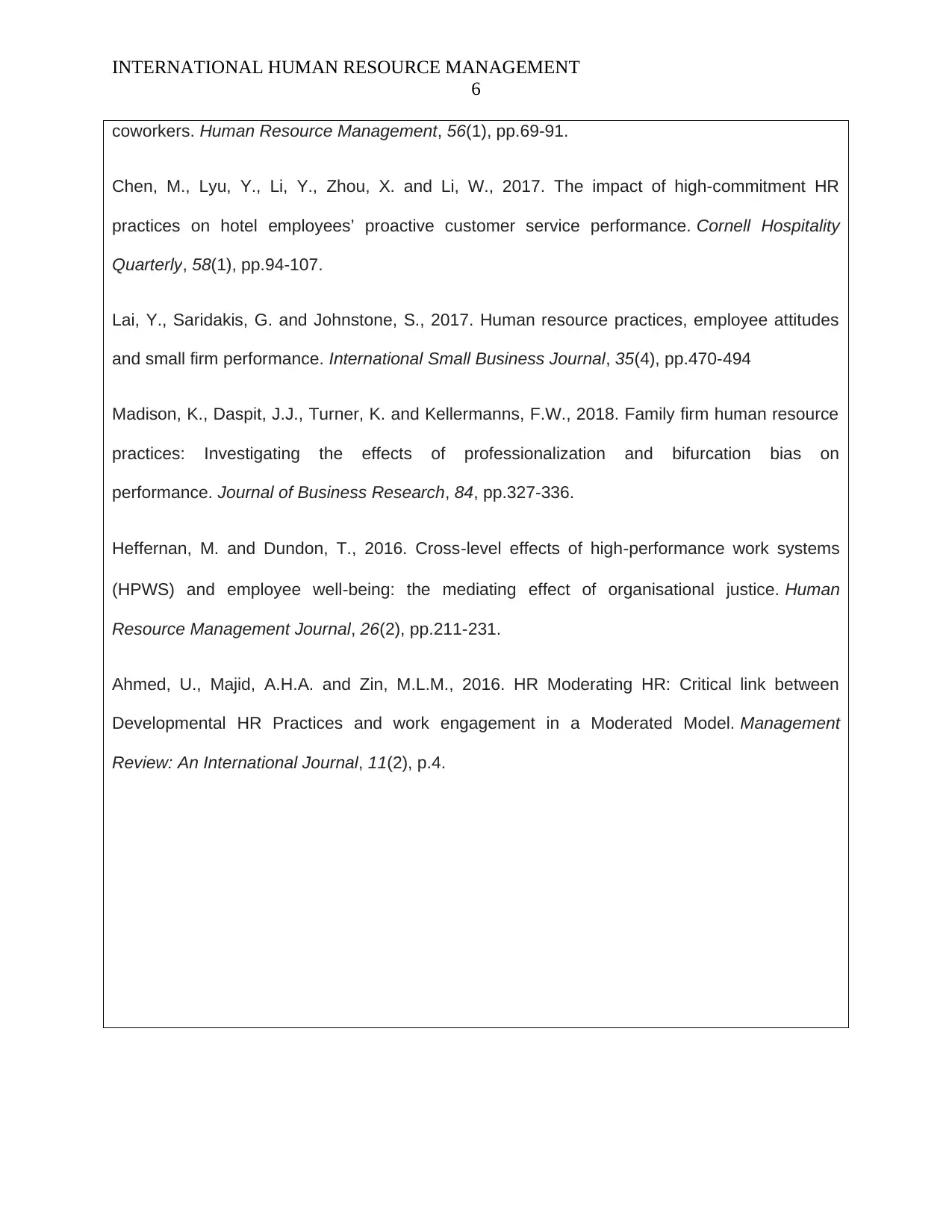
INTERNATIONAL HUMAN RESOURCE MANAGEMENT
6
coworkers. Human Resource Management, 56(1), pp.69-91.
Chen, M., Lyu, Y., Li, Y., Zhou, X. and Li, W., 2017. The impact of high-commitment HR
practices on hotel employees’ proactive customer service performance. Cornell Hospitality
Quarterly, 58(1), pp.94-107.
Lai, Y., Saridakis, G. and Johnstone, S., 2017. Human resource practices, employee attitudes
and small firm performance. International Small Business Journal, 35(4), pp.470-494
Madison, K., Daspit, J.J., Turner, K. and Kellermanns, F.W., 2018. Family firm human resource
practices: Investigating the effects of professionalization and bifurcation bias on
performance. Journal of Business Research, 84, pp.327-336.
Heffernan, M. and Dundon, T., 2016. Cross‐level effects of high‐performance work systems
(HPWS) and employee well‐being: the mediating effect of organisational justice. Human
Resource Management Journal, 26(2), pp.211-231.
Ahmed, U., Majid, A.H.A. and Zin, M.L.M., 2016. HR Moderating HR: Critical link between
Developmental HR Practices and work engagement in a Moderated Model. Management
Review: An International Journal, 11(2), p.4.
6
coworkers. Human Resource Management, 56(1), pp.69-91.
Chen, M., Lyu, Y., Li, Y., Zhou, X. and Li, W., 2017. The impact of high-commitment HR
practices on hotel employees’ proactive customer service performance. Cornell Hospitality
Quarterly, 58(1), pp.94-107.
Lai, Y., Saridakis, G. and Johnstone, S., 2017. Human resource practices, employee attitudes
and small firm performance. International Small Business Journal, 35(4), pp.470-494
Madison, K., Daspit, J.J., Turner, K. and Kellermanns, F.W., 2018. Family firm human resource
practices: Investigating the effects of professionalization and bifurcation bias on
performance. Journal of Business Research, 84, pp.327-336.
Heffernan, M. and Dundon, T., 2016. Cross‐level effects of high‐performance work systems
(HPWS) and employee well‐being: the mediating effect of organisational justice. Human
Resource Management Journal, 26(2), pp.211-231.
Ahmed, U., Majid, A.H.A. and Zin, M.L.M., 2016. HR Moderating HR: Critical link between
Developmental HR Practices and work engagement in a Moderated Model. Management
Review: An International Journal, 11(2), p.4.
⊘ This is a preview!⊘
Do you want full access?
Subscribe today to unlock all pages.

Trusted by 1+ million students worldwide

INTERNATIONAL HUMAN RESOURCE MANAGEMENT
7
7
1 out of 7
Your All-in-One AI-Powered Toolkit for Academic Success.
+13062052269
info@desklib.com
Available 24*7 on WhatsApp / Email
![[object Object]](/_next/static/media/star-bottom.7253800d.svg)
Unlock your academic potential
Copyright © 2020–2025 A2Z Services. All Rights Reserved. Developed and managed by ZUCOL.